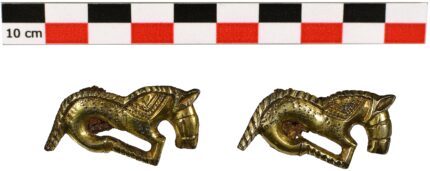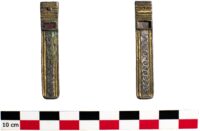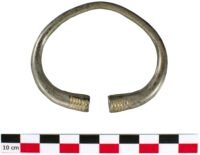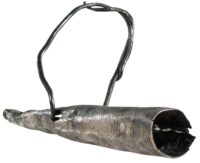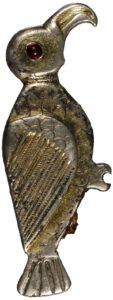 Excavation of a necropolis in the ancient Roman town of Boutae, near Annecy is southeastern France, has yielded rich Germanic funerary furnishings. Radiocarbon dating and analysis of the artifacts dates the necropolis to between the second half of the 5th century and the second half of the 7th, indicating there was a stable population of Burgundians living in Boutae after the establishment of the First Kingdom of Burgundy in the Rhineland and Savoy in 443.
Excavation of a necropolis in the ancient Roman town of Boutae, near Annecy is southeastern France, has yielded rich Germanic funerary furnishings. Radiocarbon dating and analysis of the artifacts dates the necropolis to between the second half of the 5th century and the second half of the 7th, indicating there was a stable population of Burgundians living in Boutae after the establishment of the First Kingdom of Burgundy in the Rhineland and Savoy in 443.
Boutae was founded in 27 B.C. as a vicus, a small satellite town of the main city of the Allobroges tribe. Located at the intersection of three major  Roman roads and on the Alpis Graia, the route leading to the Petit Saint-Bernard alpine pass, Boutae prospered under the Roman Empire. It was razed and much of the population killed in the Germanic invasions of the mid-3rd century, but it was rebuilt in the 3rd century. The vicus was largely abandoned in the early 5th century in the wake of the Burgundian invasion, but some of pockets of the town were used until the end of the 7th century.
Roman roads and on the Alpis Graia, the route leading to the Petit Saint-Bernard alpine pass, Boutae prospered under the Roman Empire. It was razed and much of the population killed in the Germanic invasions of the mid-3rd century, but it was rebuilt in the 3rd century. The vicus was largely abandoned in the early 5th century in the wake of the Burgundian invasion, but some of pockets of the town were used until the end of the 7th century.
The presence of graves from late antiquity on the west side of the city has been known since the 19th century, but it wasn’t thoroughly excavated and 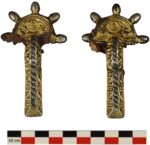 documented until last year. INRAP archaeologists explored almost half an acre and unearthed 227 graves, a fraction of the total burials at the site. There are a variety of grave types including wooden coffins, hollowed out trunks, sandstone slabs. Thirty of the graves contained high quality furnishings, either worn by the deceased or placed in the pit. Their decorative style mark the grave goods as Burgundian.
documented until last year. INRAP archaeologists explored almost half an acre and unearthed 227 graves, a fraction of the total burials at the site. There are a variety of grave types including wooden coffins, hollowed out trunks, sandstone slabs. Thirty of the graves contained high quality furnishings, either worn by the deceased or placed in the pit. Their decorative style mark the grave goods as Burgundian.
 Most of the objects are objects of adornment or grooming. There are a dozen decorated bone combs, glass beads on necklaces and châtelaines, belt buckles, shoe buckles, a three-piece toiletry kit, a silver gilt fibula shaped like a bird of prey with a garnet eye and a matched set of fibulae in the shape of galloping horses. Only two weapons were found: an arrowhead and a scramasax with a fragment of its wooden scabbard still attached.
Most of the objects are objects of adornment or grooming. There are a dozen decorated bone combs, glass beads on necklaces and châtelaines, belt buckles, shoe buckles, a three-piece toiletry kit, a silver gilt fibula shaped like a bird of prey with a garnet eye and a matched set of fibulae in the shape of galloping horses. Only two weapons were found: an arrowhead and a scramasax with a fragment of its wooden scabbard still attached.
